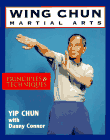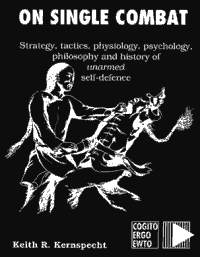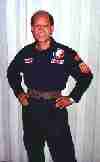Wing Chun Kung Fu
James Yimm Lee, edited by Bruce Lee, 1989
Although Bruce Lee did not complete his training in the Wing Chun system, his superior intelligence allowed him to grasp, expand, and convey the essential meaning of the art. This book, written by Bruce Lee's student, James Yimm Lee, is (in my opinion ) a wonderful introduction into the basic concepts underlying Wing Chun's fighting approach. The footwork, kicks, and applications presented in the last section of the book will probably spur some debate among Wing Chun enthusiasts. Pictures are good and easy to understand.

Complete Wing Chun: the Definitive Guide to Wing Chun's History and Traditions
Rene Ritchie, et al, 1998
The authors of the book still lament the use of "Complete" in the title, especially since their original title apparently tried to avoid any broad, all-encompassing language to indicate completeness. What this book does offer is a very interesting look into the many families of Wing Chun out there, how they train, and their origins; in the end, it draws convincing conclusions as to the evolution of the art. Pictures and illustrations serve their intended purpose of giving an idea of "what is out there."
Yuan Kay San Wing Chun
Rene Ritchie, 1999
While Grandmaster Yip Man's lineage remains the most common in the world, other families have in recent years gained more recognition. A contemporary of Yip Man, Yuan Kay San mastered a different version of Wing Chun, with its own flavor. This book details the history, methods, and applications of this lineage. Pictures illustrate techniques and ideas concisely and effectively.

Wing Chun Kung Fu, 3 volumes
Joseph W. Smith, 1992
A controversial work in the Wing Chun world, this 3 volume series has its merits and drawbacks. The author attempts to explain Wing Chun in a scientific manner, and can give a reader already versed in the style a better idea as such. However, since the photographs are often unclear, and the science is scattered in and out, a beginner might get hopelessly lost. Further, while someone who has a good foundation of Wing Chun can appreciate the unorthodox approach, a beginner may lose out on some of the fundamental ideas behind the forms. The writing style is rather dry, reading more like a sociological or scientific paper. The author also presents a fusion of Wing Chun, White Crane, and Muay Thai as a "complete" style, which he calls "Sun Tzu Kuen." Named after the great General of ancient times, I thought that was a rather arrogant name?

100th Anniversary of Yip Man Edited by the Ving Tsun Athletic Association
Containing varying articles from several different prominent Wing Chun practitioners, this book is actually a hodgepodge of essays ostensibly arranged under certain themes. A reader can find a lot of great gems among the articles, if he can get past the poor English editing (and frequent mistranslations from Chinese). Also, with several accounts and ideas that contradict one another, you can see that how, even within a single lineage, people's interpretation of Wing Chun can be different.
Wing Chun Martial Arts
Yip Chun with Danny Conner
Written by Yip Man's first son, this book has some helpful views of chi sao practice.
More to come...

Wing Tsun Kuen
Leung Ting
The Bible of Leung Ting's own Wing Tsun organization, this book offers a great overall view of Wing Chun, as well as some wonderful self-promotion as well. Leung Ting is something of a controversial figure, with some of Yip Man's students claiming that he never studied with the Grandmaster. I don't know for sure, but no matter what, the book is well-done. Given that Leung Ting's has the largest martial arts organization in the world, he must be doing something right. Pictures are well done, and demonstration of the first two forms and their applications are quite extensive. This book also has the best presentation of chi sao that I have seen in a book. Great for a beginner.
Dynamic Wing Tsun
Leung Ting
This book provides a systematic introduction to fighting drills. Given the wide range of teaching approaches, this book may or may not be helpful for your own training regimen. If your style leaves all weight on the back foot, then you may find it very useful. Otherwise, it will probably be difficult to work it into the way you practice. But then, maybe it might convince you to change your footwork.
108 Wing Tsun Wooden Dummy Techniques
Forward by Leung Ting and Yip Chun, demonstrated by Yip Man
Great reference book for those who know or are learning the dummy form. Yip Man's son Yip Chun presents a story of Yip Man which differs from an earlier story he penned. Also, because some of the original pictures were lost, Yip Chun fills in the gaps; you can really tell from the pictures that there is a significant skill difference between father and son! The applications of the dummy are very direct, taken move for move, an approach which my own Sifu would disagree with.
Introduction to Wing Chun
By Kawamura Yousou
Written by Japan's authority on Wing Chun, this great book sums up the art for the beginner. Lots of drills that can help someone develop, and insights into the different branches of Wing Chun. Shows the first from in its entirety, as well as applications. Unfortunately, the book is in Japanese.
On Single Combat
By Keith Kernspecht
Written by the second in command of Leung Ting's gigantic Wing Tsun organization, this exceptional book details the logic of the Wing (Ch)Tsun system. It examines the reasoning of simplicity and economy of motion, while meticulously describing the use of footwork, and various hand positions. It also includes mental approaches to Wing Tsun. The only negative aspect is the blatant promotion of Leung Ting's system, ignoring the fact that some things that the author claims to be unique to the Wing Tsun system are in fact common through most Wing Chun lineages. If you can cut through the politics, this is an awesome book.



